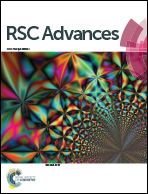Electronic structure of iron dinitrogen complex [(TPB)FeN2]2−/1−/0: correlation to Mössbauer parameters†
Abstract
Low-valent species of iron are key intermediates in many important biological processes such as the nitrogenase enzymatic catalytic reaction. These species play a major role in activating highly stable N2 molecules. Thus, there is a clear need to establish the factors which are responsible for the reactivity of the metal–dinitrogen moiety. In this regard, we have investigated the electronic structure of low-valent iron (2−/1−/0) in a [(TPB)FeN2]2−/1−/0 complex using density functional theory (DFT). The variation in the oxidation states of iron in the nitrogenase enzyme cycle is associated with the flexibility of Fe→B bonding. Therefore, the flexibility of Fe→B bonding acts as an electron source that sustains the formation of various oxidation states, which is necessary for the key species in dinitrogen activation. AIM calculations are also performed to understand the strength of Fe→B and Fe–N2 bonds. A detailed interpretation of the contributions to the isomer shift (IS) and quadrupole splitting (ΔEQ) are discussed. The major contribution to IS comes mainly from the 3s-contribution, which differs depending on the d orbital population due to different shielding. The valence shell contribution also comes from the 4s-orbital. The Fe–N2 bond distance has a great influence on the Mössbauer parameters, which are associated with the radial distribution, i.e. the shape of the 4s-orbital and the charge density at the nucleus. A linear relationship between IS with Fe–N2 and ΔEQ with Fe–N2 is observed.
![Graphical abstract: Electronic structure of iron dinitrogen complex [(TPB)FeN2]2−/1−/0: correlation to Mössbauer parameters](/en/Image/Get?imageInfo.ImageType=GA&imageInfo.ImageIdentifier.ManuscriptID=C9RA10481J&imageInfo.ImageIdentifier.Year=2020)


 Please wait while we load your content...
Please wait while we load your content...